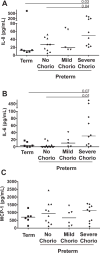Effect of chorioamnionitis on regulatory T cells in moderate/late preterm neonates
- PMID: 25451985
- PMCID: PMC4282957
- DOI: 10.1016/j.humimm.2014.10.016
Effect of chorioamnionitis on regulatory T cells in moderate/late preterm neonates
Abstract
Regulatory T-cells (Treg) have a protective role for the control of immune activation and tissue damage. The effects of chorioamnionitis (chorio) on Treg in moderate/late preterm newborns are not known. We hypothesized that infants exposed to chorio would have decreased Treg frequency and/or function. We isolated mononuclear cells from adult peripheral blood and cord blood from term and moderate/late preterm infants who were classified for severity of chorio exposure. Mononuclear cells were analyzed by flow cytometry for Treg frequency and phenotype. Treg suppression of activation of conventional T-cells (Tcon) was also quantified. Treg frequencies were similar in all groups of neonates, but lower than that found in adults. Newborn Treg had a naïve phenotype, with decreased levels of CD45RO, HLA-DR, CD39 and TIGIT compared to adult Treg and chorio did not affect the phenotype. Treg from preterm newborns exposed to severe chorio had higher expression of Ki67 compared to the other groups. Treg from preterm newborns were less suppressive than Treg from adults or term, and the level of suppression was reduced with severe chorio. Relative to term, Treg frequency and phenotype were not affected by prematurity and chorio but their functionality was decreased. Lower Treg activity may contribute to inflammation in newborns that is often associated with chorioamnionitis.
Keywords: Fetal inflammation; Full term newborn; Prematurity; Regulatory T cell; Suppression.
Copyright © 2014 American Society for Histocompatibility and Immunogenetics. Published by Elsevier Inc. All rights reserved.
Figures





References
-
- Ananth CV, Friedman AM, Gyamfi-Bannerman C. Epidemiology of moderate preterm, late preterm and early term delivery. Clin perinatol. 2013;40:601–10. - PubMed
-
- Martin JA, Osterman MJ, Sutton PD. Are preterm births on the decline in the United States? Recent data from the National Vital Statistics System. NCHS Data Brief. 2010:1–8. - PubMed
-
- McIntire DD, Leveno KJ. Neonatal mortality and morbidity rates in late preterm births compared with births at term. Obstet Gynecol. 2008;111:35–41. - PubMed
-
- Vrijlandt EJ, Kerstjens JM, Duiverman EJ, Bos AF, Reijneveld SA. Moderately preterm children have more respiratory problems during their first 5 years of life than children born full term. Am J Respir Crit Care Med. 2013;187:1234–40. - PubMed
Publication types
MeSH terms
Substances
Grants and funding
LinkOut - more resources
Full Text Sources
Other Literature Sources
Medical
Research Materials

